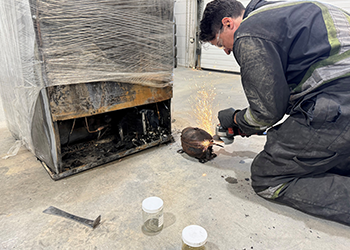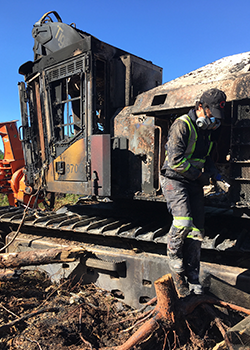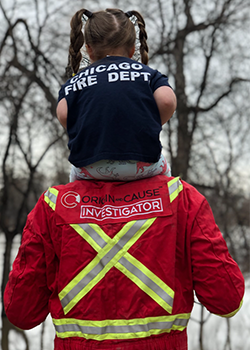
When engineering fails, forensic engineers like Matthew Obach investigate to understand what went wrong and how future failures can be prevented.

Perfection in engineering is impossible. Failure is inevitable, and sometimes, dangerous. Forensic engineers enter the scene after a failure and painstakingly reconstruct the event to determine the cause. Sometimes it comes down to design, use, or random happenstance. They function like detectives, using their observational skills alongside their knowledge of mechanics and fire science, to solve mysteries and provide answers to those in need.
Piecing together the puzzle
It was not until Matthew Obach’s second year of his Masters that he discovered fire investigation as a career option. The chance to practice forensic engineering, investigate cases, and research fire patterns was instantly appealing. “It's puzzles for adults, that is exactly what my job is,” Obach said.
“What I'm doing is not design work, it's all post-failure,” Obach explained. “When something fails and breaks or fails and starts a fire, then it's my job to go in and figure out why it failed.”
There could be any number of causes that Obach needs to systematically rule out: a design flaw, a mistake in installation or workmanship, a user error, or simply end of life for a piece of machinery. The goal is to determine exactly why it happened and stop it from happening in the future.
There’s a standard process to uncovering the truth in these cases. First, an investigator has to make observations by going to the scene and seeing the aftereffects of the failure and the fire.
“There's science behind how the fire grows and develops and creates the patterns,” Obach explained. "It's understanding that science and pattern development that allows you to be able to determine an area of origin. Once we've got that origin, we're going to examine the different items that that could have failed and caused a fire, to see what we can confirm or exclude as a cause.”

Sometimes the answer is simple, if it’s something he’s seen before or if there is one obvious cause within an origin. Other failures require further investigation and can include attempts to replicate the failure, by obtaining the same equipment and testing each piece to see what may have gone wrong.
“I used to say that I’ve never gone to the same fire twice,” Obach said. “Every day is just a different experience.”
Lasting change
The results of these investigations can lead to lasting changes that affect people throughout Canada. Obach recalls a particular case involving a fire in a passenger vehicle, in which he and his colleagues had to get creative to solve the case. They suspected the fire originated in the block heater cartridge, and that something was wrong with the shape of the hole drilled in the engine block.
“For that one, we actually went out to Michael's and got some modelling clay, so we could press clay into the hole and then pull it out in shape, to help to see what was going on there,” Obach said.
As suspected, there was an issue with how the bore hole was created. The block heater wasn't seated correctly, and therefore heat could escape and affect the electrical connection point, which resulted in an electrical failure. This discovery led to a vehicle recall through Transport Canada.
“You really do feel like you're having a direct impact on improving safety,” Obach said.
Communicating safety
Simply identifying an issue is not always enough to prevent future failures; a previous case Obach worked involving a combine header (the front component of a combine used to harvest agricultural crops) which illustrated this perfectly.
Obach identified a bearing that failed in such a way that it could have started the fire that destroyed the machine. Enough of the combine was intact that he could read the manufacturer instructions that said to grease that bearing every 40 hours. When examining a new version of the same combine header, for comparison, he found the instructions had been changed to grease the bearing every 10 hours.

In this case, the manufacturer had correctly identified a potential failure and upgraded new equipment, but this knowledge didn’t make it to the farmers who owned older versions of that combine. The communication of knowledge that is uncovered under these types of investigations are a crucial aspect to improving overall public safety.
This communication issue can also go both ways. Obach has seen exhaust temperatures on agricultural machines get so hot that they ignite organic material, but some manufacturers are skeptical and need more evidence than anecdotal accounts. He’s currently working on a research project with farmers to test exhaust temperatures while machines are being operated, so the problem can be documented in such a way that they can be authoritatively communicated to the manufacturers.
“Anything that I can identify as being an issue, that can get corrected to limit the chances of it happening again, is going to be a big way of improving public safety,” Obach said.
And in cases with catastrophic fires, knowledge can go a long way to giving a sense of peace or closure to those affected.
“It's nice when you can say, this is what caused it, and sometimes you're also able to say this is what you can do in the future so that it doesn't happen again. Other times it's just the peace of mind for people to know what happened, to know that it wasn't their fault or sometimes just giving them that definitive answer of what happened.”
Future of forensic engineering
The satisfaction of solving the puzzle and the ability to increase people’s safety is why Obach continues to dive into fire investigation. “It's amazing how many times I've worked with someone and then at the end they say, I appreciate it and thanks for coming, but I hope I never see you again... I don't take it personally.”
Obach explained that the forensic engineering field is a fairly new one. Even 30 years ago, it was much less understood and trusted than it is today. As a growing field, there are constantly new tools and techniques to aid investigators in determining the source of fires. However, the rapidly changing pace of technology means there are constantly new pieces of machinery failing in new ways.
“A big challenge that we're going to have is electric vehicles and fires.” Just as Obach sees more block heater failures in parts of the country that deal with extremely cold temperatures, the increase in electric vehicle use changes the dynamic of potential points of failure.
“We're seeing a lot of rechargeable battery failures for home appliances, tools, vacuums, that kind of thing. But as that starts going into vehicles as well, just the size and scale of that could really be a big issue. They're pretty spectacular fires when they happen,” Obach explained.

Obach knows he and his fellow engineers are up to the challenge. For future engineers, his advice is to explore all their options, and to investigate the possibilities available to them in the broad expanse of engineering fields. “When you talk about engineering, people probably have five ideas of what kind of job that means when there's hundreds of different jobs out there. If you're interested in engineering at all, then it's worth exploring what opportunities are out there. There's going to be possibilities you have not even thought of."
Engineers build more than just bridges. Building Tomorrows is a series that highlights the important contributions of engineers and the many ways they help to make our world a better place.


